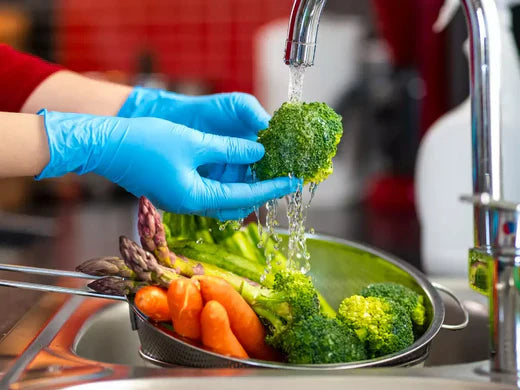Food hygiene ratings are a crucial part of the dining experience, for those eating out, grabbing takeout, or shopping for prepackaged foods. But what exactly do these ratings mean, and why are they so important? This guide will take you through everything you need to know about food hygiene ratings, from how they work to their benefits, regulations, and who uses them.
What Is a Food Hygiene Rating?
A food hygiene rating is a score given to food establishments based on how well they follow hygiene standards. These ratings are usually provided by local authorities after a thorough inspection and serve as a snapshot of the establishment’s cleanliness, food safety practices, and adherence to regulatory guidelines.
In most countries, ratings are displayed as numbers or stars, often accompanied by a certificate or sticker that businesses can showcase to their customers. For example, in the UK, food hygiene ratings range from 0 (urgent improvement required) to 5 (very good).
What is the Range of Food Hygiene Ratings in the UK?
In the UK, food hygiene ratings are issued on a scale from 0 to 5, reflecting how well a business meets legal food hygiene standards. Here’s what the ratings signify:
● 5 (Very Good): The establishment fully complies with food hygiene laws.
● 4 (Good): Some minor improvements are needed, but standards remain high.
● 3 (Generally Satisfactory): Acceptable standards with areas for improvement.
● 2 (Some Improvement Necessary): Significant work is required to address hygiene issues.
● 1 (Major Improvement Necessary): Serious hygiene issues that require significant and urgent changes to ensure food safety.
● 0 (Urgent Improvement Required): Major hygiene failings that pose risks and demand immediate action.
These ratings are crucial for consumers making informed dining choices.
Who Uses Food Hygiene Ratings?
- Consumers: Customers rely on these ratings to make informed decisions about where to eat or shop. A high rating assures diners that their food has been prepared in a clean and safe environment.
- Food Businesses: Establishments use these ratings as a marketing tool to attract customers and build trust. A good score can be a badge of honor for restaurants, cafes, and supermarkets.
- Regulatory Bodies: Local authorities and health inspectors use ratings to ensure businesses comply with hygiene laws and identify areas needing improvement.
How Do Food Hygiene Ratings Work?
1. Inspection Process
Local authorities conduct unannounced inspections of food businesses. Inspectors evaluate several factors, including:
● Food Handling Practices: How food is stored, prepared, cooked, and served.
● Cleanliness of Premises: The state of the kitchen, storage areas, and dining spaces.
● Food Safety Management: Whether the business has effective systems in place to ensure hygiene standards are consistently met.
2. Scoring System
After the inspection, the business is given a score or rating based on its performance in the above areas. The specifics vary by country, but the rating typically reflects:
● Adherence to hygiene regulations.
● Risk of food contamination.
● Overall cleanliness and upkeep.
3. Display of Ratings
Many countries require businesses to display their hygiene rating where customers can easily see it, like on the entrance door or at the point of sale. Some regions also provide online databases where customers can look up ratings.
Benefits of Food Hygiene Ratings
For Consumers:
- Informed Choices: Customers can avoid establishments with poor ratings, reducing the risk of foodborne illnesses.
- Transparency: The rating system creates trust between customers and businesses.
For Businesses:
- Improved Standards: Striving for a high rating encourages businesses to adopt better hygiene practices.
- Competitive Edge: A top rating can attract more customers and enhance a business’s reputation.
For the Environment and Public Health:
- Safer Communities: Improved hygiene reduces the spread of foodborne diseases.
- Compliance Monitoring: Ratings help authorities ensure businesses meet food safety regulations.
Regulations and Guidelines for Food Hygiene Ratings
Food hygiene ratings are governed by national or regional laws that outline specific requirements businesses must meet. These include:
- Legal Compliance
Businesses must adhere to hygiene regulations, such as proper storage temperatures, pest control, and staff hygiene practices. In the EU, this is covered under Regulation (EC) No 852/2004 on the hygiene of foodstuffs.
- Regular Inspections
Authorities conduct periodic inspections to verify compliance. In some cases, businesses with poor ratings may face follow-up visits or penalties.
- Training and Certification
Staff are often required to undergo food hygiene training to ensure they understand best practices for handling and preparing food.
How Can Businesses Improve Their Hygiene Ratings?
● Maintain Cleanliness: Regular cleaning schedules for all areas, from kitchens to bathrooms, are essential.
● Follow Safe Food Handling Practices: Proper storage, cooking, and cooling techniques prevent contamination.
● Train Staff: Ensure all employees are well-trained in hygiene protocols.
● Implement Safety Systems: Use HACCP (Hazard Analysis and Critical Control Points) to identify and control potential hazards.
● Prepare for Inspections: Keep records and perform regular self-audits to ensure compliance with regulations.
What Happens if a Business Receives a Poor Rating?
A poor hygiene rating doesn’t necessarily mean a business will be shut down immediately, but it does indicate serious areas of concern.
The local authority may require the business to make immediate improvements, conduct follow-up inspections to ensure compliance, issue fines, or even close the establishment if issues are not resolved.
For consumers, a low rating is a clear signal to avoid the establishment until improvements are made.
Conclusion
Food hygiene ratings are a simple yet powerful tool for promoting food safety, ensuring businesses meet hygiene standards, and empowering customers to make better dining choices.
By paying attention to these ratings, you’re not just protecting your health, you’re also supporting businesses that prioritize safety and cleanliness. So, the next time you spot a food hygiene rating displayed on a restaurant’s door, you’ll know exactly what it means and why it matters.
References
Safety Culture (2024). An Introduction to Food Hygiene Rating. Retrieved from https://safetyculture.com/topics/food-hygiene-rating/
Food Standards Agency. Food Hygiene Rating Scheme. Retrieved from https://www.food.gov.uk/safety-hygiene/food-hygiene-rating-scheme

